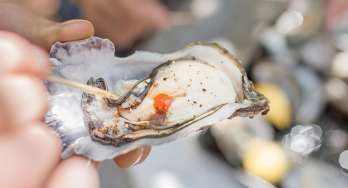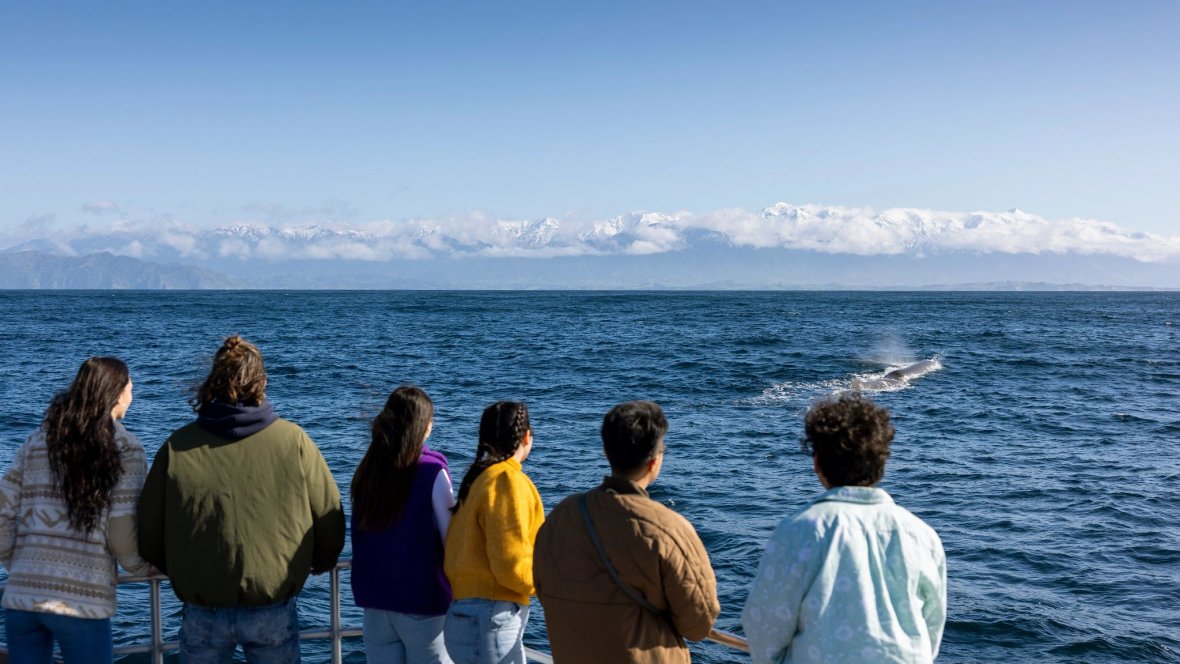


Join thousands of fellow campervan travellers
Sign up for our Britz newsletter to receive inspirational travel content and awesome deals, and we'll send you a copy of our Ultimate RV guide!
Thanks
Please confirm subscription in your email.
What whales and marine life can you see?
Sperm whales are present year-round, but you might also see:
-
Humpback whales (June – July)
-
Orca (December – March)
-
Southern right and blue whales (typically winter to spring)
Most whale watching Kaikōura NZ cruises also encounter dusky dolphins, Hector’s dolphins, New Zealand fur seals, and seabirds like the wandering albatross. For those who want a broader experience, some companies also offer combined Kaikōura dolphin tour and seal-watching packages.
How long to allow for whale watching
Allow approximately 3 hours total, including check-in, briefing, and around 2 hours on the water. Sea conditions can change quickly, so if you’re prone to seasickness, consider motion-sickness tablets and sit toward the rear of the boat.
Tours typically run multiple times a day — bookings are essential, especially in peak season.
 Image: Tourism New Zealand
Image: Tourism New Zealand
Best time to visit
Whale Watch Kaikōura operates tours year-round, with sailings scheduled throughout the day, every day except Christmas Day. While sperm whales can be seen in any season, conditions on the water and the presence of other species vary across the year.
-
Summer (December – February): Warm temperatures and calm seas make this a popular time to visit. Sightings of orca are possible during these months, and the weather is generally pleasant for being out on the water.
-
Autumn (March – May): Sea conditions are often stable, with fewer crowds. This is a good time for photography, thanks to the lower sun angles and clear air.
-
Winter (June – August): Migratory species such as humpback whales, southern right whales, and even blue whales may be seen. Be prepared for cooler weather and more frequent sea swells.
-
Spring (September – November): A transitional season with changeable weather, but a good chance to see a variety of wildlife, including newborn marine mammals.
While tours run daily, all sailings are subject to favourable sea and weather conditions.
How to get to Kaikōura
Kaikōura is located on the east coast of New Zealand’s South Island and is easily accessible by road:
-
From Christchurch: 2.5 hours (183 km) via SH1 north
-
From Picton: 2 hours (156 km) via SH1 south
-
From Hanmer Springs: 1 hour 50 minutes (130 km) via SH70
These routes form part of the Alpine Pacific Touring Route, a scenic journey through vineyards, mountains, and coastal views.
Best place to park your campervan
There’s a large, free public car park next to Whaleway Station Road, right by the tour check-in area for Whale Watch Kaikōura. It’s suitable for vehicles up to 7 m, with height-friendly bays. Overflow parking is available at the nearby Kaikōura railway station.
Campgrounds near Kaikōura
If you're travelling by campervan and planning an early cruise or overnight stay, Kaikōura has several good camping options:
-
Kaikōura TOP 10 Holiday Park – Just a short walk from town, this full-service park offers powered sites, clean facilities, and great access to restaurants and the beach.
-
Alpine-Pacific Holiday Park – Located just off the main highway, this popular spot features powered campervan sites, a hot tub, and mountain views.
-
Donegal House – A unique country pub and campground just outside Kaikōura, offering powered sites and hearty meals — perfect for a relaxed evening after a day on the water.
What to pack & practical tips
-
Dress in warm layers, even in summer — it’s cooler on the water.
-
Bring a waterproof jacket, hat, and sunscreen.
-
A camera with a zoom lens is ideal for whale and dolphin shots.
-
Take motion-sickness tablets at least 30 minutes before departure.
-
Arrive 30 minutes early for check-in and briefing.
-
If the sea conditions look rough, consider upgrading to a Kaikōura whale watching helicopter tour for a smoother experience and aerial views.
Weather in Kaikōura
Kaikōura has a mild coastal climate with changeable conditions. Summers (December – February) average 20–25 °C, while winters are cooler around 10–12 °C. Sudden southerly winds can bring rain or chop to the sea, so it’s always worth checking the forecast and dressing accordingly.
Road trips that pass through
Kaikōura is a highlight on many South Island road trips — perfect for a scenic stop between Picton and Christchurch. Try these itineraries:
